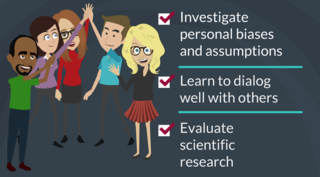Bias
Reducing Polarization: What Works?
Mandatory diversity programs often fail. Facilitated conversations may work.
Posted February 12, 2019

Recently, I spoke with Ethan Bearman on his show about why mandatory diversity programs fail and what we can do about it.
Bearman is passionate about the topic of diversity. He has been tweeting about it, and talking about it for a long time. One of his favorite quotes is from Innocents Abroad by Mark Twain. It was written in 1869. "Travel is fatal to prejudice, bigotry, and narrow mindedness." Bearman notes that it's no different today, "It seems like Mark Twain could have written this yesterday. I've known people who have like never left the county they grew up in. And I know people who are well-traveled. The most important thing is meeting and getting to know people from different cultures, that's when prejudices start melting away; because you realize people are people, and we all are different. Isn't that part of the core of teaching diversity? Experiencing other people?"
His viewpoint on the importance of traveling and meeting people from different cultures is frequently cited as an important measure to counter biased and prejudiced thinking. However, when talking to him I pointed out that bias is something that cannot so easily be outlawed, so to speak.
Research in the neurosciences reveals that we have a biological affinity for people who are like ourselves. Though we might travel or meet other people from different cultures or try what I call the command-and-control approach to outlaw our biases, 30 years of research shows that these measures are ineffective at eliminating our biases or prejudiced thinking. Just like we need oxygen or just like we can only bend our arms in one direction, we have cognitive and emotional limitations such as our strong emotional ties partly because of our histories, our memories, and our affinities.
Therefore, traveling abroad or training programs aimed at trying to eliminate or outlaw our biases are doomed to fail.
Bearman asked, "What does the research show? What actually does work? Or is there training, or anything that works?"
For the last three decades, I have been researching this question: Are there any solutions to polarization? To answer this question, I conducted social experiments of bringing children of Holocaust survivors face-to-face with children of Nazis, and later, great-grandchildren of African-American slaves with great-grandchildren of slave owners. I reported on that research in my book Justice Matters: Legacies of the Holocaust and World War II .
In addition to studying these polarized groups, I have been teaching the Harvard course, The Psychology of Diversity. This course brings together a diverse student body with different viewpoints. Research suggests that simple classroom discussions of polarizing topics can actually increase polarization. Talking about "race relations" or "personal biases" or "discrimination" can end up politicized and in debate. Similarly, conversations on these topics in the classroom can end up as arguments.
Students can get locked into their original positions and might fight and defend more than converse. In fact, research suggests that discussions of polarizing topics can actually increase polarization.
Most students enrolled in The Psychology of Diversity course, however, reported that they felt the course was transformative and helped them appreciate the viewpoints of others. Teaching fellow, Lizbeth Jacobs wanted to more carefully document our students' experiences by putting together a video of students who have taken this course.
The video documents the experiences of students from around the world who have taken the course. Have the students changed? If so, how? Watch the video to see how students from Hong Kong, Mexico, and the U.S. report on their classroom experience.
In answering Bearman's question: "What does the research show? What actually works? Is there training, or anything that works?"
Based on the research, we know what doesn't work. And that is the control-and-command approach or telling people to travel abroad. One cannot ask people to give up ties to their histories, memories, and group affinities. Their identities.
This has to be a facilitated process, and there are three kinds of learning going on during such a facilitated process.
Students are meeting each other from all over the world and learning how to dialogue with others who have different viewpoints. By dialogue, I don't mean debating. For example, conversations on race, usually end up as debates and people just become more polarized. Mark Zuckerberg of Facebook has addressed this issue. If you give people a platform to just talk and voice opinions, it can actually make things much worse. It may end up becoming more and more polarized. So, what we do in our class is we facilitate this dialogue. We have been offering this class not only in the brick-and-mortar classroom, but also online using the Zoom platform.
The second learning process that occurs in the class is that each person introspects, and investigates their own positions, and assumptions, and preferences. I prefer the word preferences to bias because when one uses the word preference there is no judgement.
For example, we have Palestinians and Israelis in our class; we have Muslims and Christians; we have Jews and Catholics; everyone has their own preferences and viewpoints. When discussing diverse viewpoints in the classroom, it is critical that the conversational process be a fair one that encourages students to reflect on their own positions, assumptions, and preferences.
And then the third learning process that is important and is missing from all training programs is that students learn how to evaluate scientific research. They are taught to evaluate data and are taught the scientific method. Then they are asked to apply scientific thinking to the topics and issues related to diversity and discussed in the class.
In conclusion, most mandatory diversity programs fail because people do not like to be told what to believe and how to behave. Most people are biologically, naturally driven to resist any external force that limits their freedom of identity. Commanding, shaming, and blaming people to get rid of their biases is, therefore, doomed to fail. Instead, what has a better probability of succeeding is a facilitated conversational process that includes recognizing other viewpoints, investigating one's own viewpoint, and applying the scientific way of thinking.
Copyright © Mona Sue Weissmark All Rights Reserved
References
Weissmark, M. (forthcoming 2019). The Science of Diversity. Oxford University Press, USA.
Weissmark, M. (2004). Justice Matters: Legacies of the Holocaust and World War II. Oxford University Press, USA.
Weissmark, M. & Giacomo, D. (1998). Doing Psychotherapy Effectively. University of Chicago Press, USA.




